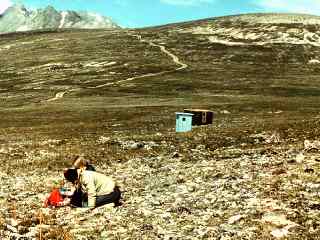|
The Alpine TundraThe tundra biome is found at high elevations in mountainous terrain, as well. Many, if not all, the same features of the arctic tundra are found in the alpine tundra. Microclimate is an important control over the distribution of plant species as slope and exposure control the availability of light and moisture. The landscape is dotted with small cushion plants, lichens and mosses. Willows are found where moisture is abundant. Other factors like soil development, movement of soil by animals, and drainage determine vegetation community distribution.
Vegetation consists of low growing shrubs, cushion plants, small forbs exploding with colorful flowers and lush meadows of sedges and grasses. These plants cover gentle slopes and rock crevices. Rock surfaces are dotted with a cover of lichens and mosses. Most species are slow-growing perennials. Plants have been forced to adapt to such an extreme environment. Plant roots store nutrients and energy during poor growing periods. Roots make up ninety percent of some plants in the alpine tundra. Flowers often are large on tundra plants. Other parts of the plant are small to save energy and reducing exposure to wind. Some plants have waxy coatings or hairs thus losing minimal heat and water to the wind. The location of plant communities is correlated with the duration of snow cover. While snow is blown free from exposed sites, it accumulates in the lee of obstructions and in depressions. Community location is also related to soil, drainage, and movement of soil by burrowing animals, and frost action throughout much of the alpine tundra. Dense willow thickets often occupy moist depressions on the lee side of ridges. A deep cover of snow during the winter protects buds from the wind and freezing temperatures. These are the tallest perennials growing above the krummholz of the ecotone. Figure 13.31 Alpine tundra fell field (foreground) and on a rocky knoll (upper right) Colorado, USA. (Courtesy UNESCO) Fell fields are colorful rock gardens exposed to the rigors of the wind. Wind removes snow throughout the season subjecting the plants to desiccation. Low-lying mats and cushion plants nestle against the rocky surface.
|
 Figure 13.30 tundra vegetation (Photo credit: Michael Ritter)
Figure 13.30 tundra vegetation (Photo credit: Michael Ritter)